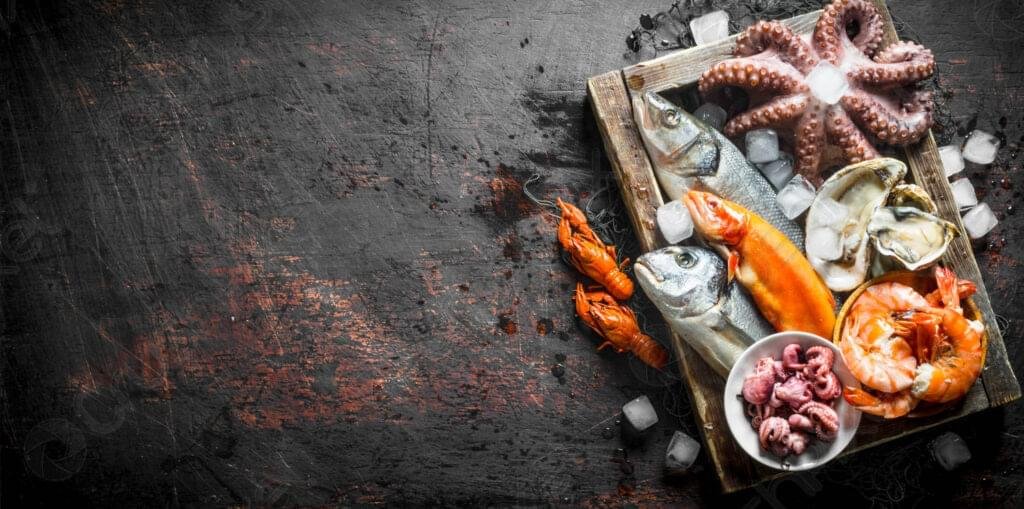Foods such as salmon, lobster, and shrimp are frequently classified as “seafood.” But how do you classify these foods when a freshwater fish, such as trout, is included? Consider the term aquatic foods (also known as blue foods), which refers to any animals, plants, or microorganisms that are born in bodies of water. Here are some examples:
- Finfish include small pelagic fish (herring, sardines, and anchovies), medium pelagic fish (bonito, mahi-mahi), large pelagic fish (tuna, swordfish), salmonids (salmon and trout), carps, cichlids (tilapia), cods (cod, haddock, and pollock), and demersal fish (flounder)
- Crustaceans include crabs, shrimp, krill, prawns, and lobster.
- Octopus and squid are examples of cephalopods.
- Clams, cockles, sea snails, mussels, and scallops are examples of mollusks.
- Water spinach is an example of an aquatic plant (Ipomoea aquatica)
- Algae—seaweed
- Other aquatic animals include mammals, insects, and sea cucumbers.
Aquatic foods are sourced from inland waters such as lakes, rivers, and wetlands; coastal areas such as estuaries, mangroves, or near-shore; and marine or ocean waters. Despite making an important contribution to healthy diets for billions of people worldwide, aquatic foods are often nutritionally undervalued because their diversity is often limited to protein or energy value, or framed as a monolithic category of “seafood or fish.” However, there is a wide variety of aquatic foods produced around the world and available at all times of the year. Wild fisheries currently harvest over 2,370 species, while aquaculture growers farm approximately 624 species.
Because aquatic foods are high in nutrients, food technologists have developed methods to produce processed fish products such as fish powders for infants, fish wafers as a snack, and fish chutneys.
This page will emphasize animal sources of aquatic foods over plant sources.
Polyunsaturated fatty acid omega-3 (DHA/EPA) source
Protein, Zinc, Iron, Magnesium, Selenium, Copper, Iodine, Vitamin A, Vitamins B6, B12, Vitamin D
Aquatic Foods and Health
Certain aquatic animal foods are high in two polyunsaturated omega-3 fatty acids (PUFAs): docosahexaenoic acid (DHA) and eicosapentaenoic acid (EPA) (EPA). These fatty acids are produced initially by certain types of algae, which are then consumed by aquatic animals, causing the fats to accumulate in their tissues or organs. Omega-3 fatty acids are found in all aquatic foods, but especially in the fatty tissue of oily fish such as salmon and mackerel, the liver of lean white fish such as cod and halibut, and the blubber, or thick layer of fat under the skin of marine animals such as seals and whales. Crustaceans, bivalves, and cephalopods also contain trace amounts. DHA and/or EPA are also found in fish oil, algal oil, and krill oil supplements. Much of the research on aquatic foods and human health is centered on omega-3 fatty acids.
According to research, replacing red and processed meat with fish and seafood can reduce the risk of disease and premature death. One reason could be differences in fat types: saturated fat in red meat vs. unsaturated fat in seafood. According to data from six U.S. cohort studies, higher consumption of red meat and processed meat was associated with an increased risk of cardiovascular disease and premature death, whereas fish was not. A large Danish cohort study discovered that replacing red and/or processed red meat with fish or poultry reduced the risk of type 2 diabetes and premature death.
Consider substituting seafood for red meat in some recipes:
- Instead of grilling burgers and ribs, marinate and bake fish.
- In place of cold cuts, try canned tuna or salmon in a sandwich.
- Include steamed mussels, canned mackerel, or sardines in your meals.
- Instead of frying a steak, bake or sauté white fish.
- Instead of beef, lamb, or ham, roast or grill salmon.
For Your Health and The Planet’s Health
Aquatic food production today is divided into two categories: wild capture and aquaculture. Wild capture production entails capturing wild fish and other aquatic species from both saltwater and freshwater sources. Aquaculture is the farming of aquatic plants and animals.
In general, the production of any animal-based food produces more greenhouse gases than the production of plant-based foods, with red meat (particularly beef and lamb) having a disproportionate impact. However, the production of aquatic foods (both wild capture and aquaculture) not only produces fewer greenhouse gas emissions and uses less land than the production of red meat, but many aquatic animal foods have a lower environmental impact than poultry production. However, in addition to emissions and land use, it is critical to consider where and how aquatic foods are produced, as environmental, social, and economic impacts can vary greatly in both the wild capture and aquaculture sectors.
Over the last few decades, the proportion of wild marine fisheries classified as “overfished” has steadily increased. According to a UN Food and Agriculture Organization assessment, the proportion of fish stocks that are “biologically sustainable” has decreased from 90% in 1974 to just under 66% in 2017. Aside from the threats to food security and human health that overfishing poses, commercial fishing at current levels can also contribute to:
- Trawling, a fishing method that captures sea creatures indiscriminately with a dragging net on the ocean floor, is destroying habitat.
- Bycatch and discards are marine species caught inadvertently while targeting other fish species and sizes.
- Fishing that is illegal, unreported, and unregulated
- Concerns about the unequal distribution of trade benefits and food access
Aquaculture is emerging to fill seafood supply gaps caused by reductions in existing wild fish stocks. Aquaculture is now the world’s fastest growing food production industry, with operations primarily in Asia (China, India, Vietnam, and Bangladesh), Europe (Norway), and, increasingly, Africa (Egypt). Aquaculture, despite its promise, must be done responsibly. Inadequately regulated aquaculture, for example, can cause environmental stressors such as freshwater use and nitrogen and phosphorus emissions, as well as negative interactions with wild fishery populations through disease transmission, antibiotic overuse, and escaped species.
To summarize, achieving the human health benefits of increased aquaculture production in a sustainable and equitable manner will necessitate policies and technologies that minimize impacts on surrounding ecosystems, industries, and communities.
Bottom Line
Aquatic foods are a diverse category of nutrient-dense, protein-rich foods that can also be a healthful animal-based alternative to red meat or other land-sourced animal foods when reducing your intake of red meat or other land-sourced animal foods. Misconceptions about aquatic foods exist, such as having a strong off-putting odor (fresh fish should not smell!) or being more expensive than other animal protein foods, which may discourage people from eating them. However, many aquatic foods are high in omega-3 fatty acids and other nutrients that aid in the prevention and treatment of cardiovascular disease and are essential for normal fetal development. They can also be delicious and filling, and can be incorporated into a variety of meals such as salads, stews, sandwiches, and main courses. Here are some recipes and cooking ideas for aquatic foods.



